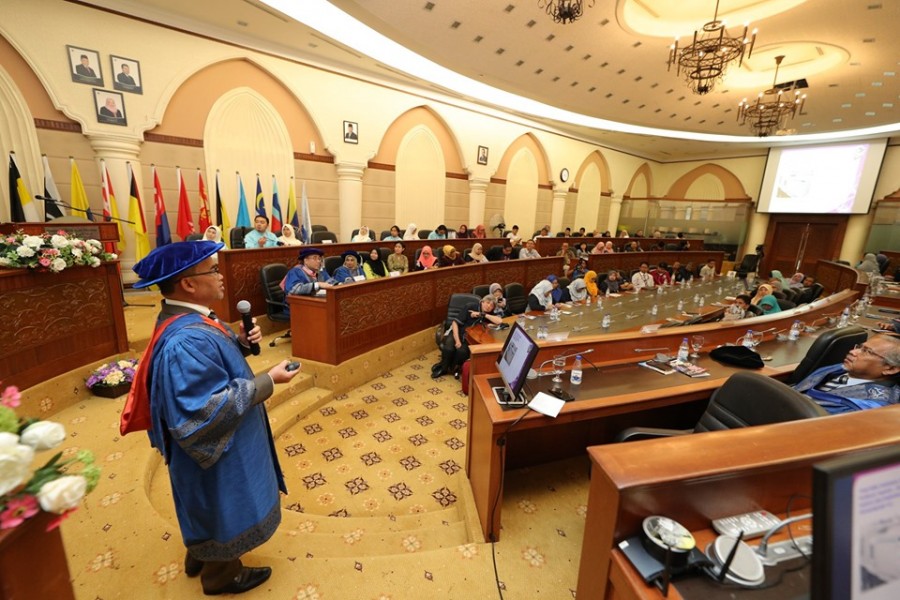NILAI, July 17, 2019- About 300 guests attended the Professorial Inaugural Lecture presented by USIM Vice-Chancellor, Professor Dato Dr Musa Ahmad at the Senate Hall, Chancellery with the title “Optical Chemical Sensor: A Practical Approach In Chemical Analysis”.
Professor Dato Dr Musa Ahmad is the Founding President of Persatuan Pembangunan Teknologi Sensor Malaysia (SENSOR), and he currently serves as the Advisor of the association. He is also a Fellow of the Academy of Sciences Malaysia (FASc) and a Fellow of the Malaysian Institute of Chemistry (IKM). He is also a Committee Member of the National Council for Islamic Religious Affairs Malaysia (MKI).
In the lecture, he remarked that a chemical sensor is a small device capable of converting chemical information in analytes into measurable electronic signals. At the beginning of the exploration into chemical sensor research, the method used to analyse chemical species was by observing the reactions that occur in solutions. Improvements to chemical sensors are made by immobilising a chemical reagent to a transducer and the reaction on the electrode surface can be observed.
Optical chemical sensors are based on the measurement of absorbed or emitted light as a result of the reaction between an immobilised reagent and the analytes. In optical sensors, light is guided using optical fibres to a photo detecting tool. The photodetector will detect the change in intensity of the absorption or reflection at certain wavelengths. The optical method has made a considerable impact on today’s chemical sensor technology and has many advantages over other methods as it involves the use of cheap and easy to obtain light sources. To date, chemical sensor research is still actively pursued and involves the latest technological developments in electronics, biotechnology, nanotechnology, advanced materials, and physics.
The use of the most advanced materials such as microchips, nano-particles, and biomass in the production of optical chemical sensors has made substantial contributions such as increased sensitivity and selectivity, the use of materials in nano quantities, and easy to use analytical procedures. The combination of artificial intelligence (AI) technology such as Artificial Neural Network (JNT) with optical chemical sensors also enables information and data processing in order to measure multiple analyte concentrations and dynamic range extensions simultaneously. This lecture will discuss the research findings of researchers in the form of several optical chemical sensor products that have been developed during more than three decades of research.
Among the interesting optical chemical sensor products that have been developed are chemical sensors for analyte detection such as capsaicin (pungency), phenol, formaldehyde (a seafood preservative), hydroquinone (skin whitening), Al(III) ion, acrylamide (carcinogen in fried food) , ammonium ion, rhodamine (colouring in shrimp paste), glutamate (food flavouring), and permethrin (wood preservative).
Also present at the event were Chairman of the University’s Board of Directors Ybhg Prof Dato Dr Siddiq Fadzil, Deputy Vice-Chancellor (Academic and International) Prof Dr Abdul Rahim Ab Rahman, Deputy Vice-Chancellor (Student Affairs and Alumni) Prof Dr Mohd Rushdan Mohd Jailani, Deputy Vice-Chancellor (Research and Innovation) Prof Dato Dr Roshada Hashim and Prof Emeritus Dato Dr Nik Mohd Nasri Nik Ismail, Research Office Director for the Development of USIM Health Complex.
Prepared by:
Noorumaina Mohamed Yunus
Pusat Komunikasi Strategik (StraComm)
Aras 1, Canselori Universiti Sains Islam Malaysia (USIM)
71800 Nilai, Negeri Sembilan



